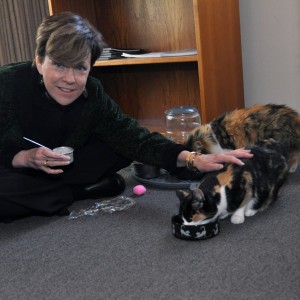 Girlie, a fluffy calico cat, has a great new home, complete with a stunning view of the San Francisco Peaks. Her bed is comfy, too, and is located by the desk in the office of Lynne Nemeth, executive director of The Arboretum at Flagstaff. Along with her relative, Cleo, they are on 24-hour rodent patrol inside the historic Walter Reichardt House, the former stone home of the non-profit organization’s founder, Frances McAllister.
Girlie, a fluffy calico cat, has a great new home, complete with a stunning view of the San Francisco Peaks. Her bed is comfy, too, and is located by the desk in the office of Lynne Nemeth, executive director of The Arboretum at Flagstaff. Along with her relative, Cleo, they are on 24-hour rodent patrol inside the historic Walter Reichardt House, the former stone home of the non-profit organization’s founder, Frances McAllister.
“Girlie rolls around when I come in the morning,” Nemeth said. “She had been named Fireball by the vet, because she was vicious, but she’s not vicious any longer, so I renamed her. They live in here, so they can roam around. They have about 3,500 square feet to take care of in the building.”
The two female cats, possibly sisters, have been living at The Arboretum since mid-October and are part of the new Working Cats Program through Paw Placement of Northern Arizona. The program is working with the Coconino Humane Association (CHA) to reduce the euthanasia rate there.
“There were in excess of 200 cats last year that were deemed feral or unadoptable and were put down, so that’s what we’re trying to address,” explained Pamela Tharp, who is on the of Paw Placement board of directors. “These two were in a hoarding situation; they don’t learn to be socialized, so that makes it really difficult to place them. Technically, we would not call these cats feral, but unadoptable. They’ve been around people, but just the wrong people.”
Tharp said animal control removed them and took them to CHA, where overcrowding ultimately led them, and their kittens, to another home at the Ark Cat Sanctuary in Parks.
“This type of program gives homeless cats a second chance at a good life,” she added.
Girlie and Cleo are the first Working Cats to be placed in a business, but other cats have already been assigned for duty at private ranches and barns.
The two cats went through a trial period at The Arboretum until the beginning of November and passed with flying colors.
“They’re doing great; since they’ve been here, we haven’t had any rodent issues in this house, so they are great deterrents,” Nemeth said. “Their job is to keep the deer mice out of here, which carry hanta-virus. We also have white-throated wood pack rats, which come into the old buildings. It just can become a health issue, but rodents also damage wiring, build nests and get into food.”
The Working Cats brochure promotes the program as “great resource” for property owners to protect their property “in an environmentally safe way and save the life of a homeless cat at the same time.”
There is no adoption fee for “hiring” a working cat.
Typical candidates for Working Cats are happier living independently or prefer to keep their distance from humans, but still need a protected or sheltered living arrangement.
When visited for this report in mid-November, Cleo hid much of the time behind a pet pen, but both cats rushed to enjoy treats from a can of wet cat food and to eat eagerly from the kibble bowl offered by Nemeth. They also let her pet them behind the ears.
“My sister and I grew up to absolutely adore cats,” recalled Nemeth, who was raised in rural Pennsylvania with 27 barn and three house cats. Girlie and Cleo have definitely settled in to their new scene.
“The cats have been very responsive to the humans here, so I’m very pleased,” Nemeth observed. “I think it’s a great way to save these cats. Everyone needs rodent control, and it’s so much better to have cats than to put poison down.”
The Arboretum, where natural habitats and cultivated gardens showcase the diverse plants of the Colorado Plateau, is pesticide free. “We’re thinking about getting cats for our horticulture building too,” she said. “But,
I don’t want them to be outside because of the birds. Also, we have a lot of coyotes, and coyotes love to eat cats. We’ve also had bobcats come through here.”
Even though not all cats are successful hunters, when cats roam around a property and leave their scent everywhere, rats depart the area on their own. Across the nation, programs such as Working Cats have placed cats with construction companies, police stations, flower shops and other businesses looking for inexpensive, safe, and effective rodent control that employs cats to do what comes naturally to them. One barn owner quoted in the brochure called having a cat on rodent duty a “classic win-win to us.” Nemeth noted cats are the apex of stealth predators: “They’re sort of at the top of their line.” Tharp said Paw Placement is exploring the idea of providing some Working Cats to attack a major rodent problem in older buildings south of Route 66 on South San Francisco Street. A side benefit of having animals in the workplace is that they can be a real boost to employee morale, Tharp says, which is certainly true of Girlie and Cleo, who have settled right in and made human friends.
“They sense they’re safe, that there’s not a threat here.”
Donations are needed to sustain the Working Cats Program and other programs at Paw Placement of Northern Arizona. “We have expenses,” Tharp said. “These cats are spayed or neutered, vaccinated and micro-chipped before placement.” QCBN
For details about “hiring” a working cat, call Paw Placement at 928-699-7586 or visit the website at www.ppnaz.org.
By Betsey Bruner







